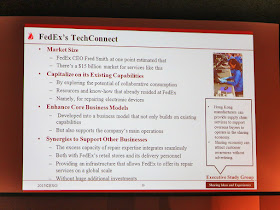In the beginning, Dr. Mark Lee introduced the aims of Executive Study Group which formed in 2008 (Financial Tsunami). Since the ESG seminar series was very success and he transferred a new form of EMBA for Lifelong Learning through Alumni Club 100. He introduced his strategic consultancy flow as following diagram.
Then Dr. Mark Lee briefed Mega Trend of Sharing Economy. He quoted TIME article talking about different habits on Ownership (traditional concept). In Sharing Economy, share products and services rather than buy or own them. Moreover, PricewaterhouseCoopers had estimated that five main sectors of the sharing economy represented USD 335 billion in revenue worldwide by 2025.
Dr. Lee arose some examples such as “Airbnb” to explain different values created by Sharing Economy that the central conceit of collaborative consumption to obtain value from untapped potential residing in goods that were not entirely exploited by their owners. There were three main types of Collaborative Consumption included (1) Product Service Systems, (2) Reownership of a Product and (3) Collaborative Lifestyles.
Another case was Zipcar. Traditional rental car charged by day but Zipcar charged by hour. Their dynamic relationship among People and Resource was demonstrated in the following diagram. Other cases included Zilok.com, NeighborGoods.net, theredUP.com, Landshare.net and Taskrabbit.com, etc.
After that Dr. Lee introduced six strategies to capitalize “Sharing Economy”.
1. Sell the “Use”, Not the Product
Dr. Lee used different examples to explain selling the “Use” and one of examples was very common in our office that was Photocopier which switched the selling machines to per page cost.
Then he quoted Prof. Theodore Levitt (Harvard Business School) famous statement that “People don’t want to buy a quarter-inch drill. They want a quarter-inch hole!”
2. Support Your Customers in Their Attempts to Resell
Dr. Lee pointed out IKEA Family which launched an online platform in Sweden in 2010 that allowed customers to resell their used IKEA goods. Then he asked audience why IKEA did it seems no revenue. One of responder said it could build their brand to be Sustainability and customer loyalty. When customer stayed in IKEA online platform, cross-selling could happen. It was one way to change ownership in Sharing Economic. Another example was Patagonia “The Stories We Wear”. Dr. Lee said that emotion factors could increase brand loyalty.
3. Take Advantage of Unused Resources and Capacities
One of example was unused office space to be rental through LiquidSpace. This platform connected Supply and Demand through virtual marketplaces. Moreover, Marriott (hotel) also rental all their meeting rooms through LiquidSpace. It was not only increase revenue, but also increase exposure to Marriott properties/services (lunch, dinner, etc.)
4. Provide Expertise Services for Repair and Maintenance
Dr. Lee said companies had expertise (such as FedEx’s TechConnect expertise for repair and maintenance) could participate in the sharing economy by “renting” their expertise to consumers.
5. Align with Collaborative Consumption to Target New Customers
It was another approach to align with peer-to-peer sharing as a platform to promote one’s products and services to potential customers such as Pepsi NEXT: The Extra Hour which was cooperated with taskrabbit.
6. Find New Business Models Based on the Sharing Economy
Dr. Lee said apart from Hong Kong cows those nothing to do, cows in Swiss also the same situation. A Swiss farmer started leasing his cows to customers instead of solely selling the cheese. Lessees paid a fee to sponsor a cow for a season and some new offerings included photo of the cow & certificate plus the option to visit the farm and to watch the daily farm work. (Kuhleasing.ch)Make your Offering “Sharing Economy” Enabled
It was the last topic Dr. Lee introduced to us. Sharing Economy had altering how people own and consume fundamentally. It was a mega trend in internet age and both threat and opportunity existed at the same time. The most important thing was to support customer needs said by Dr. Lee.
There were five common threads initiative of Sharing Economy.
- REDUCE: We make useful gear that lasts a long time You don’t buy what you don’t need
- REPAIR: We help you repair your Patagonia gear You pledge to fix what’s broken
- REUSE: We help find a home for Patagonia gear you no longer need You sell or pass it on
- RECYCLE: We will take back your Patagonia gear that is worn out You pledge to keep your stuff out of the landfill and incinerator
- REIMAGINE: Togenther we reimagine a world where we take only what nature can replace
Lastly, Dr. Lee showed Patagonia video and asked us two questions:
1. What are you afterthoughts about the video?
2. What are your views about the Patagonia?
Reference:
HKSTP - www.hkstp.org
Asia Pacific Institute for Strategy Limited (亞太策略研究所有限公司) – www.apifs.org













沒有留言:
發佈留言